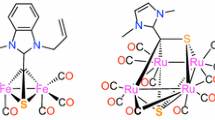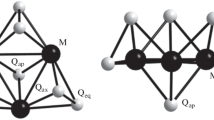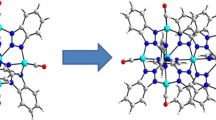Abstract
This paper focuses on the life and scientific career of Paolo Chini (1928–1980), an Italian chemist with a great experimental ingenuity. In Italy and abroad he really represented a key figure for his fundamental industrial and academic research. He took an active part on the development of polypropylene polymer synthesis pathway together with Giulio Natta and he has been a pioneer for the synthesis and characterization of high nuclearity metal carbonyl clusters: a borderline discipline between molecular and solid-state chemistry. This work also includes eyewitness testimonies of Chini’s close friends and relatives, in order to give the reader an accurate biography of this scientist.






Similar content being viewed by others
Notes
His real name was Pietro Antonio Degl’Innocenti. Pietro’s father was a foundling, and was raised by a charitable institution, “Ospedale del Bigallo”, that takes in abandoned new-born babies, and gave him the fictitious surname Degl’Innocenti. Becoming older, Pietro Antonio was given the nickname “Chini” that would originate the present surname [1].
Soon Pietro Alessio was joined by illustrious figures such as Leto Chini (1848–1910), Dario Chini (1847–1897), and Tito († 1883) who continued the artistic activity; undoubtedly another member of the family, Galileo Chini (1873–1956) would have become the most celebrated artist of the family; at the eve of the new century he become the better known member of his family across Europe and United States.
In the second decade of the twentieth century with the increasing international impulses of set designer, painter and decorator, Galileo passed the reins of the Fornaci off to his brother Chino and his young sons Augusto (1904–1998) and Tito (1898–1947). In fact, in 1911 Galileo was asked to decorate the royal palace of the King of Siam, and he spent a lengthy period abroad. Soon after the Great War and in the early twenties the young Tito Chini (1898–1947) became the true innovator: he accentuated a detachment from the Liberty themes, bringing an almost abstract rarefaction of the decorative motifs.
Italian high school for humanistic studies, where people learn ancient Greek, Latin and philosophy among the other standard subjects.
The first example of redox condensation was reported by Hieber and Schubert in 1965 for the synthesis of [Fe4(CO)13]2− [16].
A recent representative example is the isolation of [Ni12C(C2)(CO)17(AuPPh3)]− on the attempt to improve the yield of Ni6C(CO)9(AuPPh3)4 starting from a mixture of [Ni9C(CO)17]2− and Au(PPh3)Cl [18]. From the initial failure, on the base of its structural characterization, which showed a closed relation between the bimetallic product and the homo-metallic species [Ni9C(CO)17]2− and [Ni10C2(CO)16]2−, it was possible to rationalize a new improved reaction.
For example, differently to the trigonal antiprismatic [Ni6(CO)12]2− the congener platinum analog [Pt6(CO)12]2− displays a trigonal prismatic metal cage [20].
References
A. Giovannini, La storia delle manifatture Chini. (OK!Mugello, 2010), http://www.okmugello.it/borgo-san-lorenzo/la-storia-delle-manifatture-chini. Accessed December 2018.
Information reported according to Antonia Chini’s interview in October 2018.
G. C. Grosso, R. M. Martellacci, E. Marianini, M. Pinelli, and V. Silvani, I Chini a Borgo San Lorenzo, storia e produzione di una manifattura mugellana (Opus Libri 1993); F. Benzi, Ad vivendum. Galileo Chini. La stagione dell’Incanto. Affreschi e grandi decorazioni 1904–1942, 2002.
G. C. Grosso, catalogue of Museo della Manifattura Chini, (Polistampa, Firenze, 1999), p. 23; E. Marianini, La memoria dei caduti della Grande Guerra in Mugello, una ferita salvata dalla bellezza, (Noferini, Borgo San Lorenzo, 2015).
S. Guerrini, Le opere dei Chini all’Antella. Dario, Leto, Tito Chini e Manifattura Fornaci San Lorenzo nel Cimitero monumentale della Confraternita della Misericordia, 2nd edn. (Tipolitografia Contini, Sesto Fiorentino, 2012).
G. Longoni (1981). Inorg. Chem. 20, (1), 11A.
Information reported according to Giuliano Longoni’s interview in November 2017.
Information reported according to Brian Heaton’s interview in November 2018.
L. Malatesta, La Chimica Italiana (Università di Padova, 2008), p. 679.
F. Calderazzo (1981). J. Organomet. Chem. 213, ix–xii.
P. Chini, L. Colli, and M. Peraldo (1960). Gazz. Chim. Ital. 90, 1005–1020.
V. G. Albano, P. Chini, and V. Scatturin (1968). Chem. Commun. 3, 163–164.
F. A. Cotton (1966). Q. Rev. Chem. Soc. 20, 389–401.
P. Chini (1980). J. Organomet. Chem. 200, (1), 37–61.
P. Chini, G. Longoni, and V. G. Albano (1976). Adv. Organomet. Chem. 14, (C), 285–344.
W. O. Hieber and E. H. Schubert (1965). Anorg. Allg. Chem. 338, (1–2), 37–46.
S. Zacchini (2011). Eur. J. Inorg. Chem. 2011, (27), 4125–4145.
M. Bortoluzzi, I. Ciabatti, C. Femoni, M. Hayatifar, M. C. Iapalucci, G. Longoni, and S. Zacchini (2014). Dalton Trans. 43, (36), 13471–13475.
G. Booth and J. Chatt (1969). J. Chem. Soc. A, 2131–2132.
J. C. Calabrese, L. F. Dahl, A. Cavalieri, P. Chini, G. Longoni, and S. Martinengo (1974). J. Am. Chem. Soc. 96, (8), 2616–2618.
S. Martinengo, B. T. Heaton, R. J. Goodfellow, P. Chini (1977). J. Chem. Soc. Chem. Commun., 39–40.
D. M. Washecheck, E. J. Wucherer, L. F. Dahl, A. Ceriotti, G. Longoni, M. Manassero, M. Sansoni, and P. Chini (1979). J. Am. Chem. Soc. 101, (20), 6110–6112.
E. L. Muetterties (1975). 84(10), 959–986.
C. Femoni, F. Kaswalder, M. C. Iapalucci, G. Longoni, and S. Zacchini (2007). Eur. J. Inorg. Chem. 11, 1483–1486.
J. C. Calabrese, L. F. Dahl, P. Chini, G. Longoni, and S. Martinengo (1974). J. Am. Chem. Soc 96, (8), 2614–2616.
G. Longoni and P. Chini (1976). J. Am. Chem. Soc. 98, (23), 7225–7231.
G. Longoni, Thesis (University of Milano, 1967).
I. Ciabatti, C. Femoni, M. C. Iapalucci, G. Longoni, and S. Zacchini (2014). J. Clust. Sci. 25, (1), 115–146.
B. Berti, C. Femoni, M. C. Iapalucci, S. Ruggieri, and S. Zacchini (2018). Eur. J. Inorg. Chem. 2018, (28), 3285–3296.
C. Cesari, I. Ciabatti, C. Femoni, M. C. Iapalucci, F. Mancini, and S. Zacchini (2017). Inorg. Chem. 56, (3), 1655–1668.
C. Brown, B. T. Heaton, A. D. C. Towl, P. Chini, A. Fumagalli, and G. Longoni (1979). J. Organomet. Chem. 181, (1), 233–254.
C. Femoni, M. C. Iapalucci, G. Longoni, T. Lovato, S. Stagni, and S. Zacchini (2010). Inorg. Chem. 49, (13), 5992–6004.
H. Werner Landmarks in Organo-Transition Metal Chemistry: A Personal View (Springer, Berlin, 2009).
Premi della Divisione. (Società Chimica Italiana, Divisione di Chimica Inorganica), http://www.inorg.it/awards.html. Accessed January 2019.
Acknowledgements
The authors would like to thank all the numerous people who have supported us answering to our e-mail, letters and in-person interviews: Giuliano Longoni, Brian T. Heaton, Antonia Chini and her family.
Author information
Authors and Affiliations
Corresponding author
Additional information
Publisher's Note
Springer Nature remains neutral with regard to jurisdictional claims in published maps and institutional affiliations.
Rights and permissions
About this article
Cite this article
Paolieri, M., Ciabatti, I. & Fontani, M. Paolo Chini: The Chemical Architect of Metal Carbonyl Clusters. J Clust Sci 30, 1623–1631 (2019). https://doi.org/10.1007/s10876-019-01607-7
Received:
Published:
Issue Date:
DOI: https://doi.org/10.1007/s10876-019-01607-7




